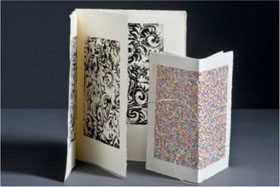STEP THREE  B
B
MATERIALS
& FORMS
INTRODUCTION
There is a great deal of variety in the methods and construction of a book or portfolio. Our intention is not to turn you into book artists, as much as offer you a range of possibilities in an effort to support the visual identity and presentation you wish to create. The work of bookbinders and book artists can involve intricate detail and exquisite craftsmanship. While this may or may not be purposeful in relation to your intentions, an understanding of what can be designed and constructed is important for developing your portfolio.
Binding
The basic goal is to make a book that functions well and allows you to present your work in a context that you have designed. In exploring how your portfolio is to be bound, flexibility is a consideration. A standard binding with a hard board cover is not something that can be easily taken apart when you wish to change the content in six months. Simpler, flexible bindings allow you to be fluid and create materials that can be easily tailored to a specific audience on-the-fly.
Some of your choices may be determined by your skills. There are numerous binding methods that allow for clean presentation and function effectively without requiring extensive experience in book construction and book binding. Furthermore, even if you hire someone to build your book for you, an understanding of the types of bindings and materials will inform the process of having your book made.
The following books and bindings are easily constructed with a minimum of skills and materials. They all take the basic form of a codex, which is a set of pages, bound together.
Glued Back-to-Back Binding
A glued binding or adhesive binding that does not allow for page replacement, but is inexpensive and easily constructed [below, p.80]. This binding allows you to print all of your page spreads on single-sided paper, and avoid the complications of two-sided or duplex printing with a desktop printer. The limitation of this binding might be that of page size and page count. A book of 30 pages up to 8 × 10 inches is a workable size and page count, as beyond this the book may require a stronger binding and spine.
Spiral Binding
This can be a flexible and inexpensive choice that is readily available and can be easily replaced. While it is used as a common office report binder, the spiral itself can be an appropriate binding as long as it fits within the visual identity you have developed.
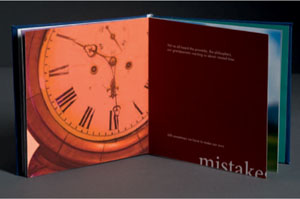
ROSIEFULTON, BACK-TO-BACKBINDING, Endicott College.
NICOLE GOBIEL, TWO SEWN PAMPHLETS, Endicott College.
Stapled or sewn pamphlet or booklet. Similar to a back-to-back binding in that it has a limited number of total pages due to its method of construction, this method is easy to create and requires either a sewn or stapled closure to hold the pages together. It does require two-sided printing to create the page spreads. There are inexpensive staplers available that are designed to accommodate the depth of the page, allowing for center stapling in the gutter or fold of the booklet.
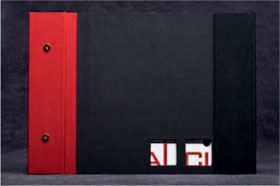
KELLY SAUCIER, POST AND SCREW PORTFOLIO, Endicott College.
Post and screw. This is a removable binding for easy replacement of pages. The pages can be single-side printed or duplex printed. These are easy-to-create bindings with hard board covers that can be opened and changed when needed without very much effort. They each have a particular appearance, but are not substantial enough as to overshadow a cover treatment.
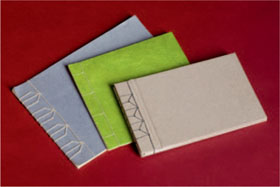
AMANDA NELSON, STAB BINDINGS, Somerville, MA.
Japanese or stab binding. This binding incorporates similar board covers as the post and screw, but has a slightly different appearance since the binding is sewn together with a three-, four-, or five-hole pattern.
BEVERLY HAYMAN, STUDENT PORTFOLIO, Mississippi State University.
As seen in Beverly Hayman's portfolio, the works are presented as an unbound set of examples in a finely crafted container that makes a professional statement.
Unconstructed binding or folio—portfolio that is not formally bound together, but held in a container as loose materials.
Covers: Softbound versus Hardbound
Constructing you own covers allows you a range of options for page design and form. Literally, you can bind anything from a standard rectangular format to a round book with round covers. Traditional hardcover books are made with “board covers.” Board covers are commonly made with book binder's or Davey board that is easily cut and glued together. Typically, binder's board is covered with book cloth, buckram (leatherette), or printed paper, but can be used raw or uncovered. Book cloth is available in a variety of colors, and is quite flexible and strong. It has a backing to prevent glue from seeping through the cloth when making covers. In designing and making your covers, standard-issue book cloth is a starting point, but take a trip to any store that has custom-made papers, or a fabric store, and you will realize that there is a rich variety of choices available to you. You can use sizing or backing on a variety of cloth to utilize it as a book covering material. Covers with materials such as metal, vinyl, wood, and plastic are all options that can be exercised as long as they feel relevant to your concept and design.

ALLISON V. SMITH, PROMOTIONAL MATERIALS, New York.
Softcovers can be made of any paper, they can be printed, and, as with board covers, made to any size you determine. Because softcovers are lighter, you can utilize a less robust binding. They offer a great deal of flexibility since any printed page can be used as a cover. Referencing the appearance of a particular type of softcover book can drive a concept as well. Comic books and Zines are good examples of softcover productions that could be utilized as a portfolio concept. Essentially a stapled pamphlet, they are easy to produce and offer great flexibility.
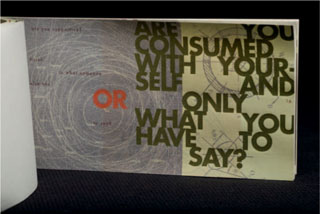
KYLIE THORN, STUDENT BOOK, Ohio University.
Spine, Hinge, and Clasp: Closed versus Open
The spine is the back edge of the book, where the pages and covers are joined. Depending on the number of pages in the book, the spine can vary in thickness. Spines can be open, as seen in a stab binding and post and screw (p. 77) and the back-to-back binding [right]. Closed-spine books don't necessarily require tying or some kind of closure. A closed spine can be made of book cloth and can be functional or decorative.
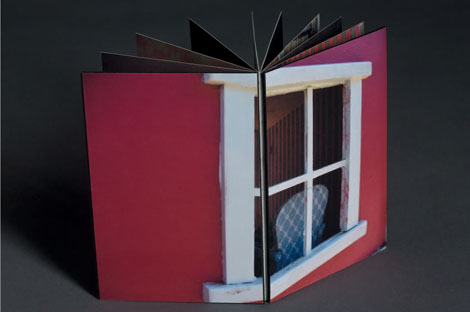
ANN PELIKAN, ARTIST'S BOOK, Ipswich, MA.
Just as the spine can be open or closed, the leading edge (fore edge) of the book can be open or closed. The leading edge of the book can have a cover or “flap” that can close via a magnet, a clasp, or any number of methods.
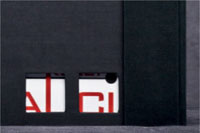
KELLY SAUCIER, MAGNETIC CLOSURE, Endicott College.
The limitation of closed-spine and closed leading edge books is that the width either of the spine or the closure needs to be made to accommodate the width of the book's assembled pages, or book block. This does not allow for significant changes to the number of pages in the book. If the book gets thinner or thicker, the binding will appear too lose, or be difficult to open and close.
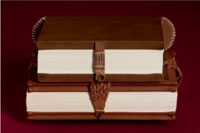
AMANDA NELSON, CLASP CLOSURES, Somerville, MA.
As simple cloth tie can be an elegant way to create a closure for a bound book, or folio. Book artists often create custom clasps from wood, plastic, bone, and metal. Common hardware and closures can be repurposed into book binding clasps and hinges and are worth exploring as well.

AMANDA NELSON, BONE CLOSURES, Somerville, MA.
Variation: Sewn or Stitched Bindings or Nonadhesive Bindings
There are a great many intricate nonadhesive bindings that incorporate decorative sewing of the spine to construct the book. These can be elaborate and elegant. The nature of this binding style can create an emphasis on the craft and material of the book, as the method of binding is distinct and a visible element. Depending on the body of work and the concept behind the portfolio, this element of the book's construction and structure can contribute to the visual identity of the individual who incorporates it. This example (right) is a sampler of sewn binding stitches. From left to right: kettle, coptic, double cord (raised cord), single cord (raised cord), recessed cords, tapes, kettle.

AMANDA NELSON, STITCHING SAMPLER, Somerville, MA.
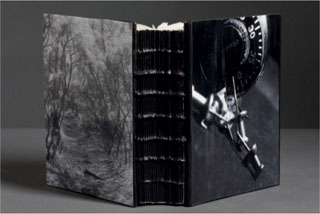
AMY GRIGG, COPTIC STITCHED BINDIG, Endicott College.
Wood, Metal, and Alternative Materials
Cover materials do not have to be derived from standard book binding supplies. The choices are unlimited if you wish to explore other kinds of fabrication and book covers can be made out of a variety of materials other than traditional board and cover stock. Metals can be hinged and fabricated to create a unique look and feel. Plastic and vinyl can form colorful and durable covers that can contribute to a unique visual identity. The range of such choices is a function of the visual concept you wish to explore and the practicality of making and maintaining the book. Making a unique object can be an effective way to have your work stand out from the other portfolios that are being reviewed. We recommend exploring the book binding resources in Appendix A as well as online resources to learn about the possibilities for book construction.
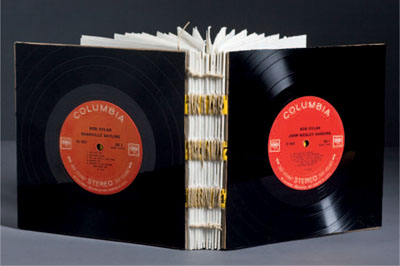
AMY GRIGG, COPTIC STITCHED BINDING, Endicott College.
Windows, Cutouts, and Insets
In making a custom cover, you can embellish the cover form with various elements. Beyond the cover cloth or papers used, a cover can have windows revealing an inner page, and those can vary in size depending on the relationship of the cover image to the interior page. Making a cutout in a board cover is a simple matter of cutting and measuring prior to construction. The layout and content of the interior page behind the cover needs to be designed and considered to work with the cutout or window.
Inset images, labels, or other visual elements can be built into a cover design as well. The inset can create a focal point on the cover and allow for a custom label or title. This again is a simple matter of preparing the book board prior to covering it (see Step 5: Book Construction).
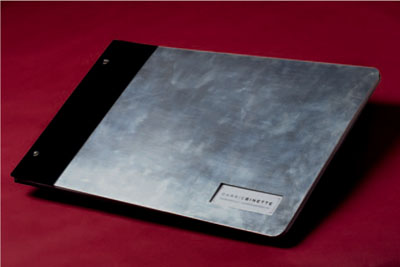
CARRIE BINETTE, GALVANIZED STEEL COVER, Endicott College.
Accordion-Fold Bindings and Concertina Bindings
Accordion-fold or fan-fold books provide an opportunity to present a sequence of images or images and text that can be easily printed and assembled. Covers can be glued or nonglued, and made of board or papers. There are many variations and printing is simplified by having to only print to one side of a page. Longer sequences can be achieved by joining folded sections with glued tabs or folded pieces.
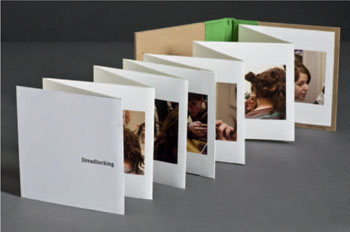
HILARY BOVAY, ACCORDION – FOLD BOOK, Endicott College.
In this variation (left), wraparound board covers with a hinged spine are built and the folded book is attached to one end panel. Once opened, the book can be extended out to be seen in its entirety, or can be viewed folded as sets of facing pages.
For folded pleat or expanded pleat [bottom left], a strip of paper is folded and pages are attached to the fan-folded strip. This allows for spacing between each page depending on how thick the folds are in the pleated strip.
Separate covers: In this variation [bottom right] by David Le, the accordion-folded sequence is adhered by the end pages to two separate board covers. This book can have closures, which can wrap the book or an independent closure for each edge.
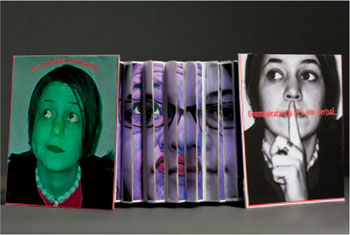
MEGHAN PHILLIPS, ACCORDION – FOLD BOOK, Endicott College.

DAVID LE, PANORAMIC IMAGE, ACCORDION – FOLD BOOK, Endicott College.
KATHERINE KING, STUDENT PORTFOLIO, Endicott College.

ALISON MURPHY, STUDENT PORTFOLIO, Massachusetts College of Art & Design.
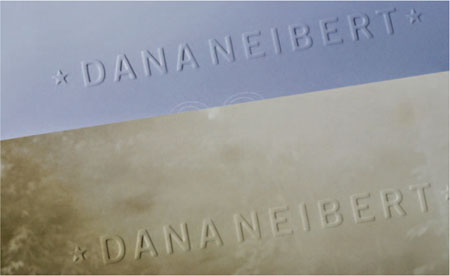
DANA NEIBERT, PROMOTIONAL WITH EMBOSSED FLAP, Coronado, CA.
Folded Pages and Inserts
A folded page can be built into a single set of pages or as a component of the entire book. This allows for the presentation of multiple images or a series of works without having to distribute them over multiple pages. Images that may require a longer aspect ratio than that of the overall book can also be presented with an extended page that is folded [opposite page top left and right]. Inserts allow one to include additional pieces within the portfolio. These can be constructed items, or samples of a particular piece, or a leave-behind, such as an electronic version of the portfolio.
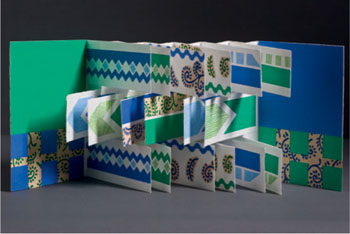
NICOLE GOBIEL, FLAG BOOK, Endicott College.
Flag Books
Flag books represent more complex page construction and visual interaction as a result of the binding method. They reflect the potential for books to be more than simply a device to hold and organize images or text, but a complex object.
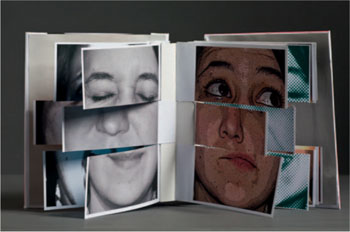
MEGHAN PHILLIPS, FLAG BOOK, Endicott College.
Pop-Up Books
Taken further, the pop-up book extends the physicality of the flag book. Again, the possibilities are numerous, and if appropriate, allow for unique presentations. In the example (opposite page lower left), a project by, Allison Murphy creates a variation on the pop-up by the use of a pull-out transparency element which is built into a page.
Embossing
With embossing [opposite page, lower right], text is imprinted into the paper, creating a raised impression. Commercial printers can create custom dies to emboss (or deboss creating a depressed imprint) paper.

ANGELA KLEMPNER, BLURB, SOFTBOUND AND HARDBOUNDVERSIONS, Endicott College.
Commercially Available Book Binding
Many individuals and artists are using book printing services through online retailers. With the development of digital short-run printing, online book printing services have grown. These services run the gamut from consumer-oriented low-cost book creation options via online photo hosting and finishing sites, to those which are aimed at professional photographers and artists. The range of options in terms of format, customization, paper stock, and print quality is quite varied. Frequently referred to as “print on demand,” the greatest advantage of these services is lower cost than traditional book printing and the ability to create one-off versions. This allows for tests and adjustments as well as changes, and creating books tailored to specific work and clients. There are numerous services, and one should seek out those who specialize in photo books or image-based books. Self-publishing services for text-based books are less likely to consider issues of design or the quality the reproductions.
Consumer Retail Services
Online photo-finishing services offer book or album creation options that usually are perfect bindings or hardcover bindings. These are a relatively new phenomenon and can offer interesting alternatives that are inexpensive and of reasonable quality. They typically use proprietary software for layout and uploading your book and have a number of standard-size book/page combinations. The limitations of these providers are often the paper stock and image quality. The biggest issue for the designer is the lack of fine control over the placement and treatment of type. Most of the software systems used to create books are not intended for sophisticated and precise control of image and text. All that being said, they can provide an option for limited-run multiple editions and are inexpensive even when printing only one book at a time.
Apple's iPhoto, Shutterfly, Kodak Gallery, and Snapfish are a few examples. They are very inexpensive, and with a little diligence one can produce a fairly good product. The consistency of the finished product may be an issue here as well but they are so low cost one could probably print multiple tests to work out the bugs if necessary. What you produce becomes your face in the world, so if better control over the design and production is needed, there are a number of options. Blurb, Shared Ink, LuLu, and VioVio offer low-cost options, with good quality and choices of hard and softcover bindings.
Blurb, for example, uses a proprietary formatting software that can be downloaded for free and makes it fairly simple to work to put together your book. They have a number of fixed formats and options, including text formatting, multiple-image page layouts, hard or softcover from the same layout, and uploading directly from the software. With a little bit of work, one can produce a high-quality single book or inexpensive multiples that could even be used as leave-behinds.
Vio Vio offers options to create a book with browser-based software, and for better control, you can create PDF files that can be uploaded. They have specifications for the PDF allowing you to work in Indesign, Illustrator, or Photoshop with much greater control over the page design and typography.
Professional Services: Asukabook, Paperchase, and Pitko Photobooks
These are examples of print-on-demand services that are oriented toward professional photographers and artists. They have higher-quality papers and inks and offer professional services such as proofing, custom stamping, and embossing. In each case, books can be designed, and built with templates or with custom-designed variations. The costs here are at least 50 percent more per book, but one has the ability to proof, select paper stock, and make a much higher-quality product.
Color Management
The use of ICC (International Color Consortium) workflows is becoming more of the norm with online publishing services. Asukabook does offer ICC profiles, or in the case of Blurb, you are directed to customers who have employed a color-managed workflow with some success. In both cases this is recommended, because reproduction quality is essential. The use of color profiling allows you to preview or soft proof all your images in relation to the type of printer to be used by the service. Color management and ICC workflows are discussed more in Step 5, Book Construction.
Web Links
Apple Photo Books: http://www.apple.com/ilife/iphoto/print-products.html
Shutterfly: http://www.shutterfly.com/
Kodak Gallery: http://www.kodakgallery.com/
Snapfish: http://www.snapfish.com/
Blurb: http://www.blurb.com
Shared Ink: http://www.sharedink.com
LuLu: http://www.lulu.com/
VioVio: http://www.viovio.com/
Asukabook: http://asukabook.com/
Paperchase: http://www.paperchase.net/
Pitko Photobooks: http://www.pikto.com/books)

